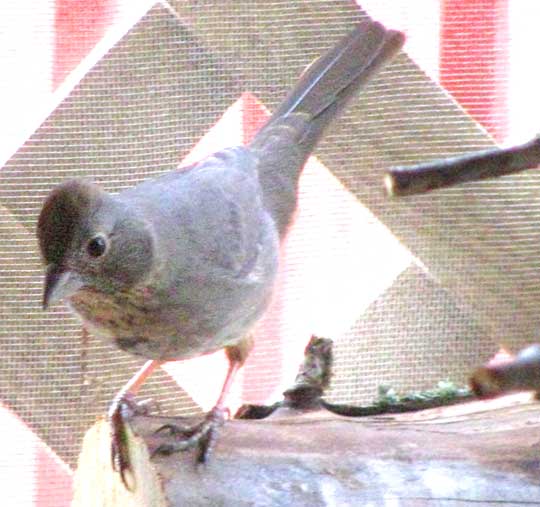Excerpts from Jim Conrad's
Naturalist Newsletter
from the February 3, 2013 Newsletter issued from the valley of the Dry Frio River in northern Uvalde County, southwestern Texas, on the southern border of the Edwards Plateau; elevation ~1750m (~5750 ft); N29.62°, W99.86°; USA
CANYON TOWEE
A persistent peeping arose from the screened-in back porch so I went to see what it was. A robin-size bird had entered through a door left ajar and now couldn't get out. Below you can see a picture of the upset bird, a little grainy because of the porch's dim light:

This is one of those birds whose nondescript plainness is so manifest that the lack of a good field mark is itself a good field mark. The bird is all brown, except that the brownness sort of curdles on the chest, plus there's a flush of rusty reddishness on the crown and beneath the tail. Otherwise, it's just the quintessential medium-sized, brown bird.
In the old days I called this bird the Brown Towhee. However, because the Brown Towhee species always was recognized as displaying a good bit of variation throughout its range, and because of the experts' usual taxonomic persnicketiness and the advent of genetic sequencing, the old Brown Towhee species has been abolished. The Pacific Coast population has been split off to form the California Towhee, and birds we have here and in upland central Mexico are now known as Canyon Towhees. Earlier the Brown Towhee's scientific name was Pipilo fuscus, but now most literature calls our population MELOZONE FUSCA. Most authorities place the species in the Sparrow/Bunting family, the Emberizidae, but some assign it to the Finch Family, the Fringillidae.
Whatever name you use, this is a fine little bird. If you're familiar with the Eastern and/or Spotted Towhees of broader distribution in North America, you know that those species often hang around suburban homes and like to get in shadowy places such as beneath hedges and scratch the ground like old hens. Canyon Towhees display these same sociable and appealing features, plus you also run into them in some of the wildest arid to semiarid brushy scrub imaginable, where they can be as shy and secretive as any quail. Here at the cabin the one in the photograph has a special affinity for scratching beneath the spreading, head-high pricklypear cactus just outside the porch door. In Spanish the Canyon Towhee is often known as "Rascador Arroyero," which means something like "gully scratcher."
Of course the scratching is for food, mainly seeds in the winter and insects and other small arthropods in the summer, and earthworms are a delight for it anytime.